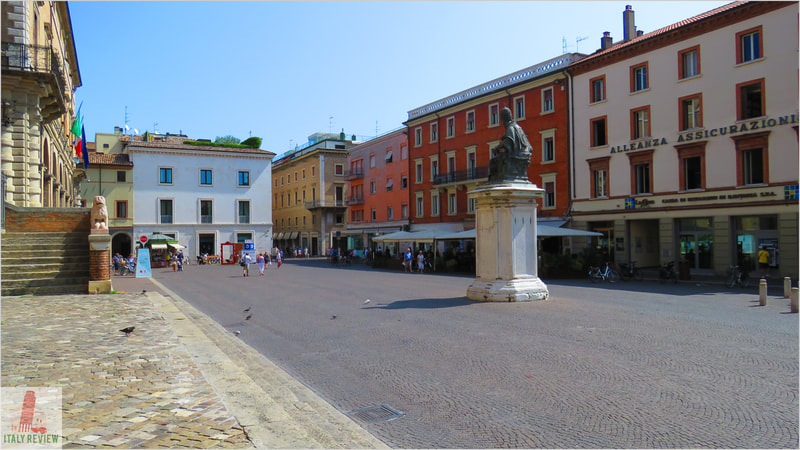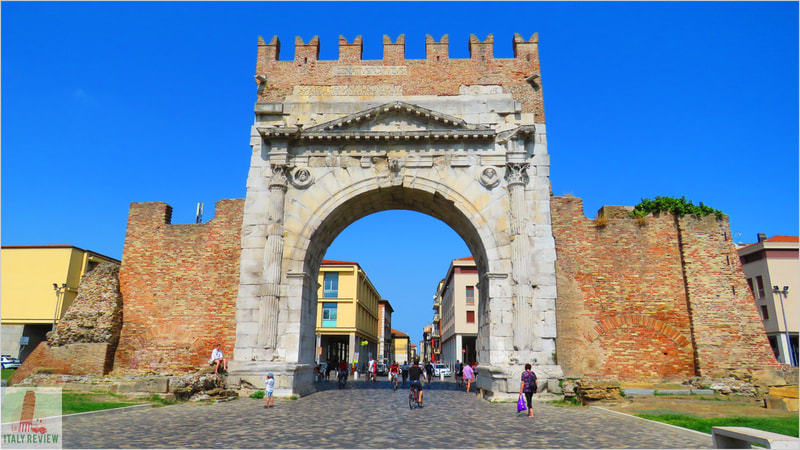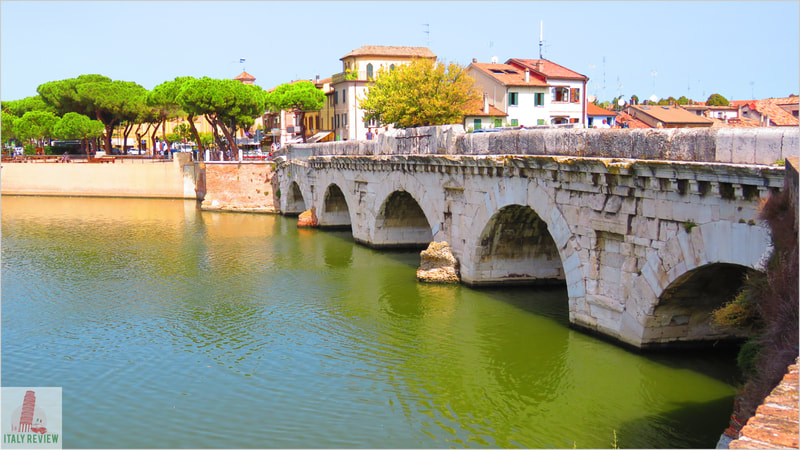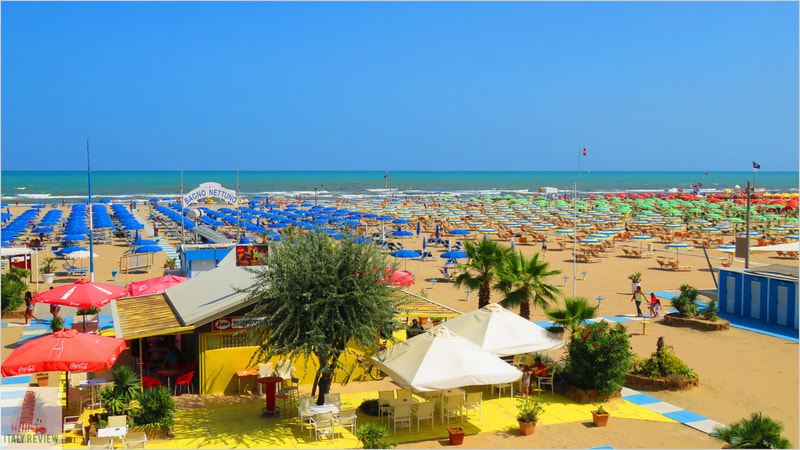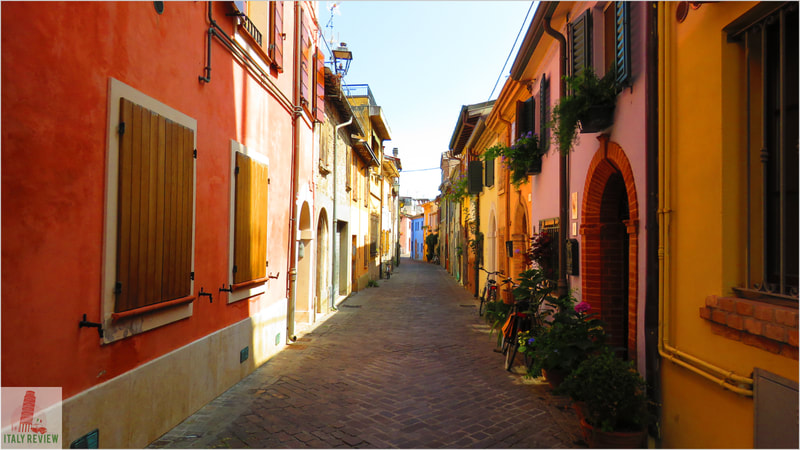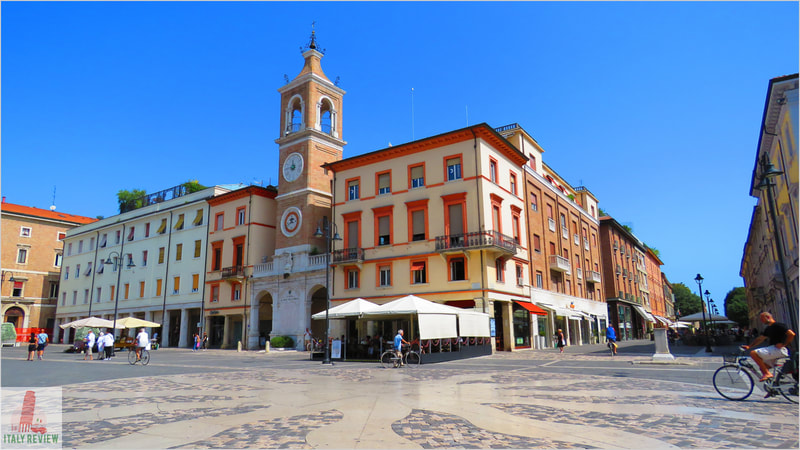Rimini
|
By Dion Protani
|
Latest update: 30 December 2023
|
|
The city of Rimini is the capital city of the Province of Rimini with a population of 150,756 inhabitants.
Situated on the Adriatic Coast, it covers a total area of 134 km² and lies 118 kilometres south east of Bologna, the regional capital of Emilia Romagna. Known principally as a beach resort and for its associated nightlife, Rimini does however have an historic centre that greatly contrasts its more famous attractions. |
Related links
Roman foundations
Founded in 268 BC by the Romans, the city was originally called Ariminum and there are some obvious traces from that period still in evidence today. The first sign of that era comes in the form of what many people consider to be the symbol of Rimini: the Arco di Augusto.
Built in 27 BC, the 17 metre high triumphal arch was commissioned by the first Roman Emperor, Augustus, and stands almost entirely intact to this day. The Arch marks the southern entrance to the city's old town, the centro storico, while at the opposite end we find another Roman monument, the Ponte di Tiberio.
Named after Rome's second emperor, Tiberius, the bridge was built in 27 AD and marked the beginning of the ancient Via Emilia road which connected Rimini to Piacenza.
Built in 27 BC, the 17 metre high triumphal arch was commissioned by the first Roman Emperor, Augustus, and stands almost entirely intact to this day. The Arch marks the southern entrance to the city's old town, the centro storico, while at the opposite end we find another Roman monument, the Ponte di Tiberio.
Named after Rome's second emperor, Tiberius, the bridge was built in 27 AD and marked the beginning of the ancient Via Emilia road which connected Rimini to Piacenza.
The historic centre
Rimini's centro storico is characterised by wide boulevards and beautiful piazzas, the most important of which are Piazza Tre Martiri and Piazza Cavour. Piazza Tre Martiri is home to the Torre dell'Orologio (Clock Tower) and the Chiesa dei Paolotti. It's also a great place for shopping, lined as it is with shops in porticoed arcades around its edges.
From Piazza Tre Martiri it's just a 2 minute walk to one of Rimini's most famous monuments: the Tempio Malatestiano. Originally built in the 13th century in Gothic style, the church was transformed in 1450 by the city's ruler, one Sigismond Malatesta.
Said to be a wicked and unjust leader, Malatesta was so grief-stricken by the death of his mistress, Isotta degli Atti, that in 1450 he hired the great Florentine Renaissance architect Leon Battista Alberti to convert the building into a shrine to her. As a result of this, then Pope Pius II excommunicated Malatesta, and condemned the building as a "temple of devil worshippers".
From Piazza Tre Martiri it's just a 2 minute walk to one of Rimini's most famous monuments: the Tempio Malatestiano. Originally built in the 13th century in Gothic style, the church was transformed in 1450 by the city's ruler, one Sigismond Malatesta.
Said to be a wicked and unjust leader, Malatesta was so grief-stricken by the death of his mistress, Isotta degli Atti, that in 1450 he hired the great Florentine Renaissance architect Leon Battista Alberti to convert the building into a shrine to her. As a result of this, then Pope Pius II excommunicated Malatesta, and condemned the building as a "temple of devil worshippers".
Federico Fellini: Rimini's film-maker supreme
Away from the controversial Tempio Malatestiano and heading back towards Piazza Tre Martiri, following the shopping street called Corso d'Augusto for 5 minutes brings you to Piazza Cavour.
Slightly smaller than Piazza Tre Martiri, it's no less grand with its Gothic buildings, the Palazzo del Podestà and Palazzo dell'Arengo on one side and the Teatro Amintore at one end. It's also home to the Peschiera Antica, an 18th century fish market that these days specialises in antiques.
Returning to Corso d'Augusto and turning left, you shortly arrive at a very special place and a source of great pride to the locals. The Cinema Fulgor is where one of Rimini's favourite sons, the legendary Italian film producer Federico Fellini watched his first ever movie.
Another couple of hundred metres along Corso d'Augusto from the cinema brings you to the Ponte di Tiberio. The bridge spans the Ariminus River which leads down to the main marina at the northern end of the beach, two kilometres away.
However, if at this point you cross the bridge it takes you into another fascinating area of Rimini, the Borgo San Giuliano. A residential area, it's characterised by its multi-coloured houses, some of which are decorated with murals on the outside.
Slightly smaller than Piazza Tre Martiri, it's no less grand with its Gothic buildings, the Palazzo del Podestà and Palazzo dell'Arengo on one side and the Teatro Amintore at one end. It's also home to the Peschiera Antica, an 18th century fish market that these days specialises in antiques.
Returning to Corso d'Augusto and turning left, you shortly arrive at a very special place and a source of great pride to the locals. The Cinema Fulgor is where one of Rimini's favourite sons, the legendary Italian film producer Federico Fellini watched his first ever movie.
Another couple of hundred metres along Corso d'Augusto from the cinema brings you to the Ponte di Tiberio. The bridge spans the Ariminus River which leads down to the main marina at the northern end of the beach, two kilometres away.
However, if at this point you cross the bridge it takes you into another fascinating area of Rimini, the Borgo San Giuliano. A residential area, it's characterised by its multi-coloured houses, some of which are decorated with murals on the outside.
The beaches of Rimini
Once you leave the Borgo San Giuliano it takes around 20 minutes to reach the beach but it's an attractive walk where you'll pass hundreds of boats of different shapes and sizes along the way.
Walking to the end of the River Ariminus you'll eventually arrive at Rimini's Ferris Wheel which marks the northern end of the city's main beach. From this point there are dozens of private beaches from which to take your pick. The beach stretches out seemingly endlessly from this point, all the way down to Gabbicce Mare in the neighbouring region of Marche, some 21 kilometres away.
The two main areas of Rimini, the centro storico and the beach are two kilometres apart, a walk of around 25 minutes. Some of that walk can be offset by taking a number 11 bus to the train station, from which point it's an 8 minute walk of 700 metres to Piazza Tre Martiri.
Walking to the end of the River Ariminus you'll eventually arrive at Rimini's Ferris Wheel which marks the northern end of the city's main beach. From this point there are dozens of private beaches from which to take your pick. The beach stretches out seemingly endlessly from this point, all the way down to Gabbicce Mare in the neighbouring region of Marche, some 21 kilometres away.
The two main areas of Rimini, the centro storico and the beach are two kilometres apart, a walk of around 25 minutes. Some of that walk can be offset by taking a number 11 bus to the train station, from which point it's an 8 minute walk of 700 metres to Piazza Tre Martiri.
Comune di Rimini
|
Province: Rimini
Region: Emilia Romagna Population: 149,169 (source: ISTAT 1 January 2023) Size: 136 km² Highlights: Tempio Malatestiano, beaches, Arch of Augustus Close by: Cesenatico, Cesena, Forlì, San Marino, Pesaro Recommended accommodation: Erbavoglio Hotel |
Rimini Travel
It's possible to take a non-stop train from Rimini to Bologna with a journey time of 55 minutes, the same train eventually making its way to Milan (2 hours 5 minutes) with an intervening stop at Reggio Emilia (1 hour 22 minutes). Heading south from Rimini you can take a train all the way down the coast to Taranto (7 hours 11 minutes) in the Puglia region, or a bit closer to home, to the neighbouring seaside resort of Riccione (9 minutes).
There's no question of which airport is the most convenient for the city; Rimini has its own airport located just seven kilometres from the city centre. Alternatives include Bologna Guglielmo Marconi Airport (123 km) and Marche Airport (93 km), further down the coast towards Ancona.
There's no question of which airport is the most convenient for the city; Rimini has its own airport located just seven kilometres from the city centre. Alternatives include Bologna Guglielmo Marconi Airport (123 km) and Marche Airport (93 km), further down the coast towards Ancona.
|
By car: Cesena - 35 minutes (35 km), Forlì - 45 mins (53 km)
Fly to: Rimini & San Marino Airport - 13 mins by car (7 km) |

